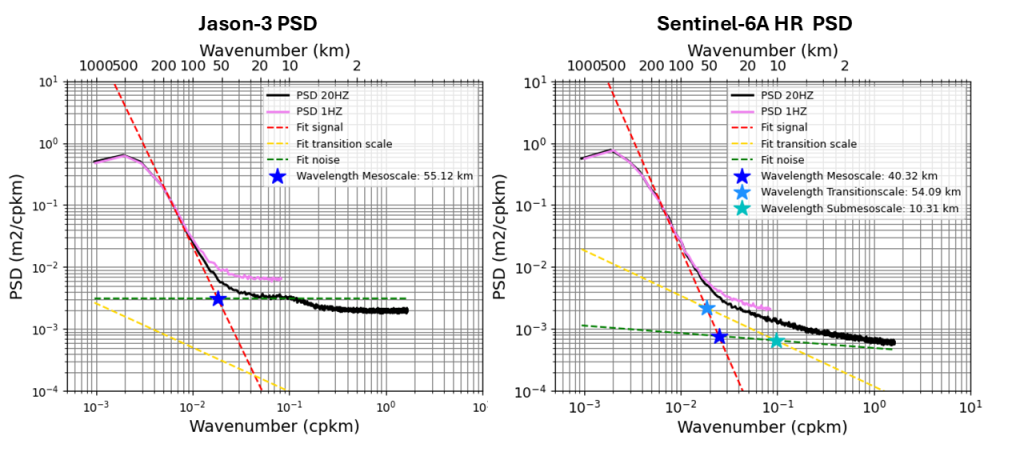Start of the L3 5 Hz production over the Europe area
DUACS-NG system version change : 1.0.0
Implementation date : November 2022
On November 29th 2022, new datasets were added to the NRT catalogue. They consist in L3 along-track measurements delivered with nearly 1 km sampling resolution (i.e., 5 Hz) over Europe. These L3 5 Hz datasets allow us to resolve wavelengths from ~40 km (S6A) to ~55 km (J3) depending on the altimeter considered (see QUID document). This is a first estimation of the observable wavelengths for mesoscale signal, done over a reduced temporal period (April-June 2022) and in the North-East Atlantic part. Values obtained could thus be influenced by the seasonal variability of the signal in the area, and should be reviewed as soon as possible over a longer temporal period. Nevertheless, compared to the conventional 1 Hz processing observing capabilities (i.e., ~65 km), these values are reduced by ~38% (S6A) to ~15% (J3). These results are induced by the relatively lower noise level obtained with the full-rate measurements compared to the conventional 1 Hz processing, visible on the following figure (energy level of the 1 Hz Power Spectral Density ( PDS) higher than for the 20 Hz PSD at short wavelengths). In the case of Jason-3, the specific noise reduction correction applied (see DUACS NRT altimeter standards) strongly contribute to this result.

The processing used for the high sampling L3 altimeter is based on the new version of the DUACS system, originally developed for processing the 1 Hz upstream altimeter measurements (Dibarboure et al., 2011; Ducet et al., 2000; Le Traon et al., 1998a; Pujol et al., 2016; Taburet et al., 2019). This new version is identified as DUACS-NG. This system has here been specifically adapted for the processing of full-rate (20 to 40 Hz) upstream products. The method is essentially the same as that for the historical 1 Hz production. It is described in duacs-system-description page. The main differences consist in:
- The use of high frequency (20 Hz) upstream measurements
- The use of specific empirical corrections able to reduce as much as possible the measurement noise, as it is considerably higher for 20 Hz measurements compared to 1 Hz. This step is necessary if we want to explore the small mesoscale.
- The use of a gridded MSS reference surface, rather than a mean profile (MP) defined along the tracks of the different repetitive missions. Indeed, the temporal period currently processed in 20 Hz does not allow to estimate an MP with higher accuracy than the current MSS available. Nevertheless, the position of the theoretical measurements is used to collocate the measurements for the different cycles of the mission. The theoretical location is delivered as a new variable in the dataset as described in the associated PUM
- A low-pass filtering is applied to the SLA in order to reduce the residual noise and at the same time keep as much as possible of the physical signal at small wavelengths. Two filters are considered:
- Filtering at very short wavelength, fixing the cut-off frequency at the 5 Hz Nyquist frequency. This filter allows to subsample the signal in order to estimate a “raw” SLA with a 5 Hz sampling.
- Filtering aiming to remove the short wavelengths for which the measurement noise dominates the signal. It applies s a cut-off frequency tailored of the observable wavelengths specific to each mission. Unlike the standard 1 Hz processing, this cut-off wavelength is not fixed but varies between altimeters, ranging from 40 to 55 km 40 and 55 km.
- The computation of the geostrophic current in the across-track direction is included in the processing. This processing will however not be activated from the beginning of the L3 5 Hz production, but should be activated in November 2024befor this dateassociated variables will thus be filled with Default Values (DV) values in a first time.
- A final subsampling is applied. The L3 along-track products are delivered at a 5 Hz (i.e., nearly 1 km) sampling rate.
Measurements from only few altimeters are processed with the 5 Hz sampling. Currently, the processing is applied on the different Copernicus missions (Sentinel-6A, Sentinel-3A/B) and Jason-3. It could be extended to other opportunity/collaborative missions in a near future.